Sony Group TMRBT10A Bluetooth Audio Transmitter User Manual HDX 2017
Sony Corporation Bluetooth Audio Transmitter HDX 2017
User Manual
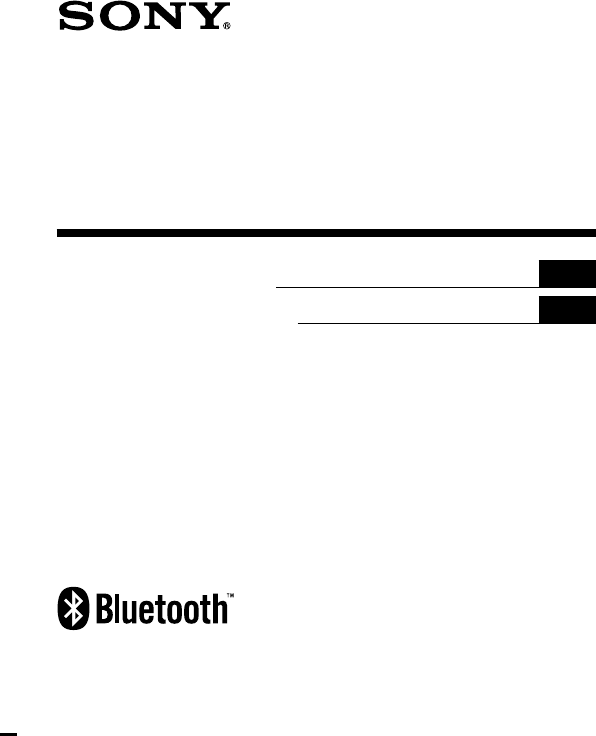
Portable Stereo
Transmitter
3-280-223-11(1)
TMR-BT10A
© 2007 Sony Corporation
Operating Instructions
Manual de instrucciones ES
US

2
US
WARNING
To reduce the risk of fire or electric
shock, do not expose this
apparatus to rain or moisture.
To reduce the risk of electrical
shock, do not open the cabinet.
Refer servicing to qualified
personnel only.
Do not install the appliance in a confined
space, such as a bookcase or built-in
cabinet.
To reduce the risk of fire, do not cover the
ventilation of the apparatus with
newspapers, tablecloths, curtains, etc.
And do not place lighted candles on the
apparatus.
To reduce the risk of fire or electric
shock, do not place objects filled with
liquids, such as vases, on the apparatus.
Connect the AC power adaptor to an
easily accessible AC outlet. Should you
notice an abnormality in the AC power
adaptor, disconnect it from the AC outlet
immediately.
Do not expose the battery to excessive
heat such as direct sunlight, fire or the
like.
For the customers in the USA
Owner’s Record
The model number is located at the side
of the unit, and the serial number is
located inside the holding clip.
Record these numbers in the spaces
provided below. Refer to them whenever
you call upon your Sony dealer regarding
this product.
Model No. TMR-BT10A
Serial No.
Information
This device complies with Part 15 of FCC
Rules.
Operation is subject to the following two
conditions: (1) this device may not cause
interference, and (2) this device must
accept any interference, including
interference that may cause undesired
operation of this device.
You are cautioned that any changes or
modifications not expressly approved in
this manual could void your authority to
operate this equipment.
This equipment must not be co-located or
operated in conjunction with any other
antenna or transmitter.
This equipment complies with FCC
radiation exposure limits set forth for
uncontrolled equipment and meets the
FCC radio frequency (RF) Exposure
Guidelines in Supplement C to OET65.
This equipment has very low levels of RF
energy that it is deemed to comply
without testing of specific absorption ratio
(SAR).
The Bluetooth word mark and logos are
owned by the Bluetooth SIG, Inc. and any
use of such marks by Sony Corporation is
under license.
Other trademarks and trade names are
those of their respective owners.
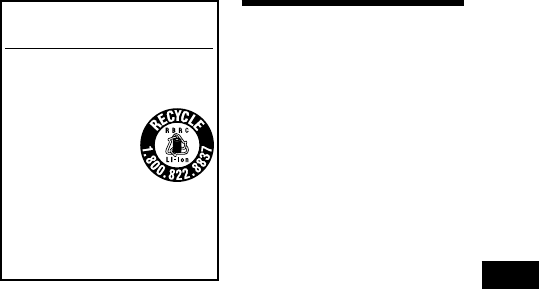
3
US
US
Table Of Contents
What is Bluetooth wireless
technology? .................. 4
Welcome! .......................... 5
3 steps to Bluetooth function .... 6
Location and Function of
Parts............................... 7
Charging the unit ............. 8
Pairing ............................. 10
What is pairing? ...................... 10
Procedures of pairing .............. 10
Indications of
Bluetooth
function
...... 12
Listening to music ......... 13
Disposing of the unit ..... 15
Precautions .................... 16
Troubleshooting ............. 18
Initializing the unit ......... 20
Specifications ................. 21
RECYCLING LITHIUM-ION
BATTERIES
Lithium-Ion batteries are recyclable.
You can help preserve our environment
by returning your used rechargeable
batteries to the
collection and recycling
location nearest you.
For more information
regarding recycling of
rechargeable batteries,
call toll free 1-800-822-
8837, or visit
http://www.rbrc.org/
Caution: Do not handle damaged or
leaking Lithium-Ion batteries.

4
US
What is Bluetooth wireless
technology?
BluetoothTM wireless technology is a
short-range wireless technology that
enables wireless data
communication between digital
devices, such as a computer or
digital camera. Bluetooth wireless
technology operates within a range
of about 10 m (about 30 ft).
Connecting two devices as
necessary is common, but some
devices can be connected to
multiple devices at the same time.*
You do not need to use a cable for
connection, nor is it necessary for
the devices to face one another, such
is the case with infrared technology.
For example, you can use such a
device in a bag or pocket.
Bluetooth standard is an
international standard supported by
thousands of companies all over the
world, and employed by various
companies worldwide.
*This unit cannot be connected to
multiple devices at the same time.
Communication System
and Compatible Bluetooth
Profiles of this unit
Profile is standardization of the
function for each Bluetooth device
specification. This unit supports the
following Bluetooth version and
profile:
Communication System:
Bluetooth Specification version 2.0
Compatible Bluetooth Profile:
–A2DP (Advanced Audio Distribution
Profile)
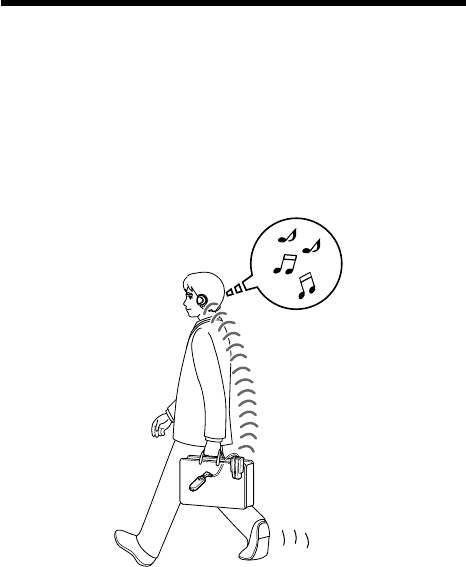
5
US
Welcome!
Thank you for purchasing this Sony Portable Stereo Transmitter. This unit
uses Bluetooth wireless technology.
•Wireless transmitter for streaming of high-quality stereo music from
digital music player.
•Transmits music to other devices using Bluetooth wireless technology.*
•Useful rechargeable function.
*The connected Bluetooth device is required to support A2DP (Advanced Audio
Distribution Profile).
Enjoy listening to music
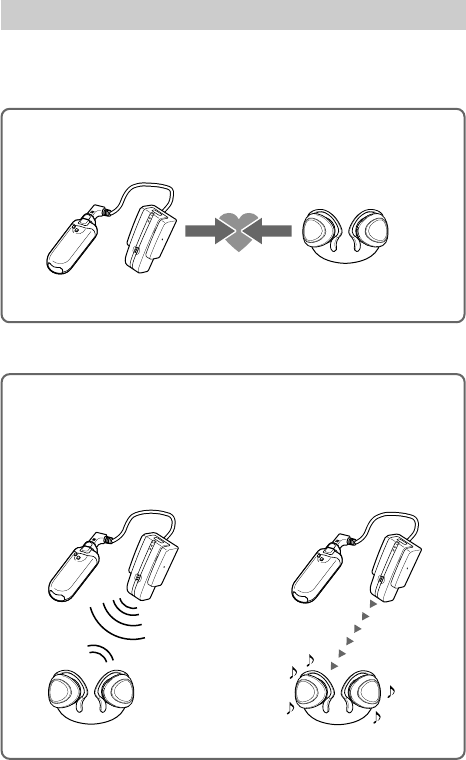
6
US
3 steps to Bluetooth function
In the example below, we explain how to transmit music played on your
audio device connected to this unit and listen to music on a Bluetooth stereo
audio receiving device (headphone, stereo audio system, etc.).
Pairing
Enables a Bluetooth stereo audio receiving device and this unit to
recognize one another.
Bluetooth connection
Turning on this unit
automatically makes the
Bluetooth connection
between this unit and the
Bluetooth stereo audio
receiving device.
Transmitting music
You can enjoy listening to
music played on the portable
audio player, etc., connected
to this unit through the
Bluetooth audio receiving
system.
b
v
Portable Stereo
Transmitter
Connection
Pairing
Stereo audio
signal
(Streaming)
Audio
device
For more details, see pages 10 - 11.
For more details, see page 13 - 14.
Bluetooth stereo audio
receiving device
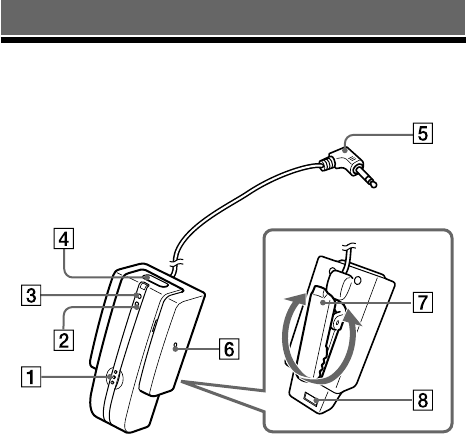
7
US
Location and Function of Parts
GETTING STARTED
1Initialize button
2Indicator (red)
Indicates the power status of
the unit.
3Indicator (blue)
Indicates the communication
status of the unit.
4POWER button
5Audio in plug (Gold-
plated L-shaped stereo
mini plug)
Connects to the headphone
jack of a portable audio
player, etc.
6RESET button
Press when the unit becomes
inoperative.
Pairing information is not
deleted by this operation.
7Holding clip
Adjust the holding clip to the
desired angle and clip to your
bag.
8Terminal for the battery
charging stand
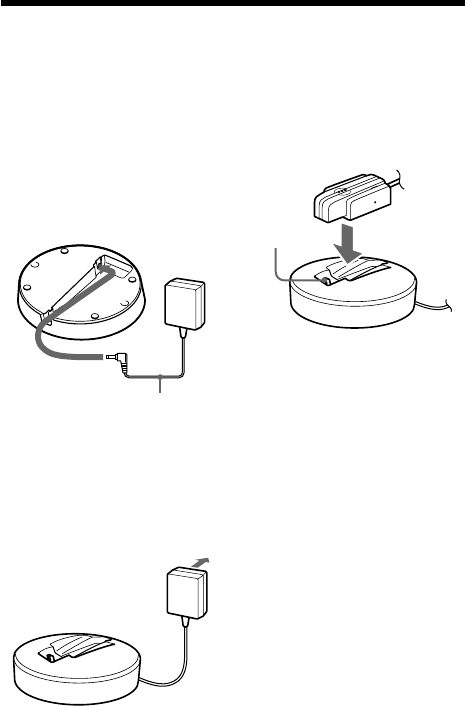
8
US
1Connect the supplied
AC power adaptor with
the battery charging
stand.
2Connect the supplied
AC power adaptor to an
AC outlet.
Charging the unit
The unit contains a rechargeable Lithium-Ion battery, which should be
charged before using for the first time.
Battery charging
stand (supplied) (Rear)
AC power
adaptor
(supplied)
3Put the unit on the
battery charging stand.
Note
If the holding clip is turned, the unit
cannot be set on the battery charging
stand and charging does not start.
Turn the holding clip back to the
original position before charging.
Rest the unit on the battery
charging stand so that the unit’s
terminal for the battery charging
stand meets the contact pin on
the battery charging stand, and
make sure that the indicator
(red) lights up.
Charging is completed in
about 3 hours* and the
indicator (red) goes off
automatically.
*Time required for empty battery
to recharge.
Tip
When charging the battery, the unit is
turned off automatically.
To an AC
outlet
Portable Stereo
Transmitter
Contact pin
Battery charging
stand (supplied)

9
US
Status
Full
Mid
Low
(needs to
charge)
Approx.
usage hours
11 hours
Checking the remaining
battery
When pressing the POWER button
while the unit is turned on, the
indicator (red) flashes. You can
check the remaining battery by the
number of times the indicator (red)
flashes.
Indicator (red)
3 times
2 times
1 time
Note
You cannot check the remaining battery
immediately after the unit is turned on, or
during the procedure for pairing.
When the battery is almost empty
The indicator (red) flashes slowly
automatically.
When the battery becomes empty, the unit
will turn off automatically.
Caution
If this unit detects a problem while
charging, the indicator (red) may
turn off, although charging is not
complete.
Check for the following causes:
–Ambient temperature exceeds the range
of 0 °C – 40 °C (32 °F – 104 °F).
–There is a problem with the battery.
In this case, charge again within the
above-mentioned temperature range.
If the problem persists, consult your
nearest Sony dealer.
Notes
•If the battery is not used for a long time,
battery may be quickly depleted,
however, after a few recharges, battery
life will improve.
•If the life of the built-in rechargeable
battery drops to half the normal length,
the battery should be replaced. Consult
your nearest Sony dealer for
replacement of the rechargeable battery.
•Avoid exposure to temperature
extremes, direct sunlight, moisture,
sand, dust or mechanical shock. Never
leave in a car parked in the sun.
•Use only the supplied AC power
adaptor. Do not use any other AC
power adaptor.
Usage hours*
Status
Music playback
time (up to)
*Time stated above may vary, depending
on ambient temperature or conditions of
use.
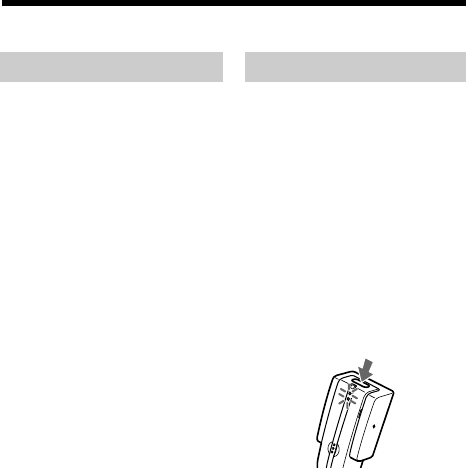
10
US
Pairing
What is pairing?
Bluetooth devices need to be
“paired” with each other beforehand.
Once Bluetooth devices are paired,
there is no need for pairing again,
except in the following cases:
•When pairing information is
deleted after repair, etc.
•When this unit is paired with 9 or
more devices.
This unit can be paired with 8
Bluetooth devices; if a new device
is paired after 8 devices have been
paired, the device whose latest
connection time is the oldest
among the 8 paired devices is
replaced by the new one.
•When recognition of the unit by
the device to be connected is
deleted.
•When this unit is initialized
(page 20).
All pairing information is deleted.
Note
Passcode* of this unit is fixed at “0000.”
This unit cannot be paired with a
Bluetooth receiving device whose
Passcode is not “0000.”
*Passcode may be called “Passkey,”
“PIN code,” “PIN number,” or
“Password.”
Procedures of pairing
1Place a Bluetooth
receiving device within
1 m (3 ft) of this unit.
2
Press and hold the
POWER button for 7
seconds or more to
standby for pairing while
the unit is turned off.
The indicator (blue) and the
indicator (red) start flashing
together and this unit starts
searching the Bluetooth
receiving device.
Notes
•After about 3 seconds, power is
turned on and the indicator
(blue) and indicator (red) flash
together twice. Keep the button
pressed without releasing until
both indicators start flashing
together, then release the button.
This unit enters into pairing
mode.
•
If pairing is not established
within about 5 minutes, pairing
mode will be canceled and this
unit will turn off. In this case,
start over from step 1.
11
US
3Set the Bluetooth
receiving device to
pairing mode.
This unit searches the
Bluetooth receiving device
automatically, and pairs the
device.
The unit tries to connect the
Bluetooth receiving device
soon after detecting it.
When the Bluetooth
connection is made properly,
the indicator (red) goes off
and the indicator (blue) starts
flashing more slowly,
indicating pairing is complete
and pairing information is
memorized on this unit.
Notes
•If Passcode input is required on
the Bluetooth receiving device,
input “0000.”
•The message standing for
“Pairing complete” appears on
the display of some Bluetooth
receiving devices.
•When pairing is complete, some
Bluetooth devices may connect
with the unit automatically.
Tips
•To pair with other Bluetooth devices,
repeat steps 1 to 3 for each device.
•To delete all pairing information, see
“Initializing the unit” (page 20).
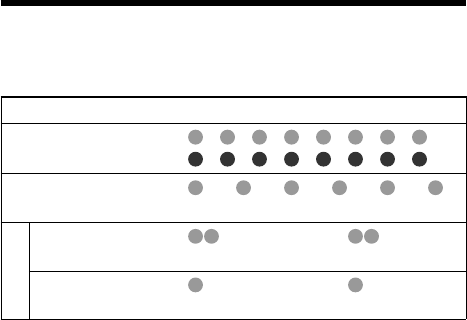
12
US
Indications of Bluetooth function
B: Indicator (blue)
R: Indicator (red)
Status Flashing patterns
Pairing B – – – – – – – – ...
R – – – – – – – – ...
Connecting B – – – – – – – – – – ...
R
–
Listening B – – – – – – – – – – – – ...
R
–
With no music B – – – – – – – – – – – – – – ...
R
–
Connected
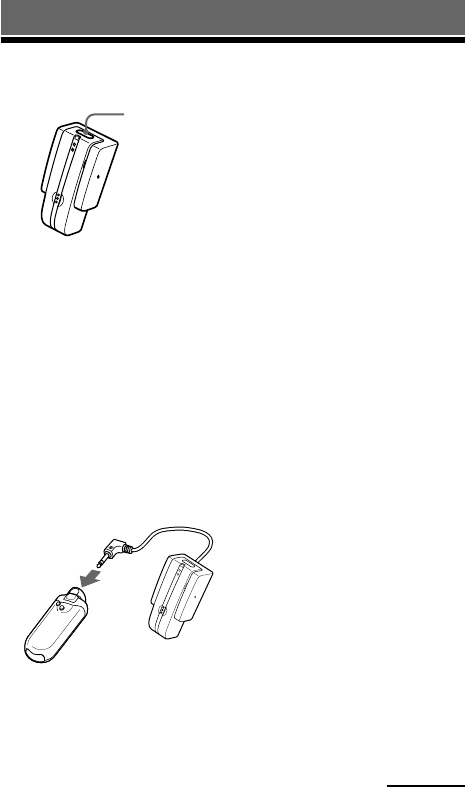
13
US
Check the following before
operating the unit.
–Pairing of this unit and the
Bluetooth receiving device is
complete.
–The Bluetooth receiving device is
on standby for connection.
–The Bluetooth receiving device
supports the receiving music
function (profile: A2DP*).
1Connect the stereo mini
plug of this unit to the
headphone jack of a
stereo audio source
device.
Note
When connecting to a stereo audio
source device, be sure to connect
this unit to the headphone jack, not
to the LINE OUT jack.
Listening to music
2Turn on the stereo
audio source device.
3Press and hold the
POWER button for
about 3 seconds while
the unit is turned off.
The indicator (blue) and
indicator (red) flash together
twice, then the unit is turned on.
After the unit is turned on, it
connects to the Bluetooth
receiving device automatically.
Notes
•Do not press and hold the
POWER button for more than 7
seconds, otherwise pairing mode
is entered.
•Make sure to turn on only the
Bluetooth receiving device you
want to connect with this unit. If
many Bluetooth receiving
devices are turned on, the
connection may not be done as
you desire.
•If this unit cannot make the
Bluetooth connection with a
paired device, pair the device
again, or try making the
Bluetooth connection from the
Bluetooth receiving device if
possible.
Tips
•While searching a Bluetooth
receiving device, the indicator
(blue) keeps flashing.
OPERATING THE UNIT
POWER
button
Continued
14
US
• If two or more devices are paired
with this unit, this unit tries to
connect with either of the last
two devices recognized before.
•Bluetooth connection of this unit
is established with A2DP
(Advanced Audio Distribution
Profile)*.
•For details on how to operate the
Bluetooth receiving device, refer
to the operating instructions
supplied with the device.
*For details on profiles, see page 4.
4Start playing on the
stereo audio source
device connected to this
unit.
Notes
•If sound is distorted, turn down
the volume of the connected
device.
•If volume is low or noise occurs,
turn up the volume of the
connected device.
•Turn off the bass boost function
or equalizer function. If these
functions are on, sound may be
distorted.
Tips
• Turn up the volume of the stereo
audio source device as high as
possible to the extent that sound
is not distorted, then adjust the
volume on the Bluetooth
receiving device to a moderate
level.
•If this unit is in your bag, the
Bluetooth connection may
decline. Clip this unit on the bag.
Notes
•Even if the Bluetooth receiving device
supports AVRCP (Audio Video Remote
Control Profile), this unit cannot
perform playback control functions.
•In the following cases, you need to
make the Bluetooth connection again.
–The power of this unit does not turn
on.
–The power of the Bluetooth stereo
audio receiving device does not turn
on, or the Bluetooth function is off.
–The Bluetooth function of this unit or
the Bluetooth stereo audio receiving
device is in sleep mode.
–The Bluetooth connection is not
made.
To stop use
1Turn off the Bluetooth
receiving device.
2Press and hold the
POWER button on this
unit for about 3
seconds.
The indicator (blue) and
indicator (red) light up
together, and the unit turns off.
Tip
When you finish playing music, the
Bluetooth connection may terminate
automatically, depending on the
Bluetooth device.
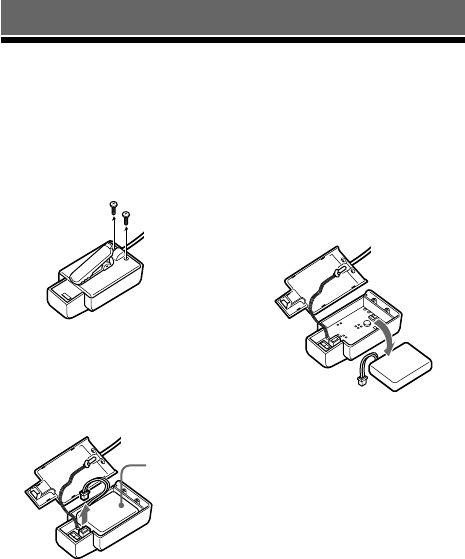
15
US
Disposing of the unit
For environmental conservation, be sure to remove the built-in rechargeable
battery from the unit before disposing, and dispose of the battery
appropriately.
ADDITIONAL INFORMATION
1Remove 2 screws.
2Open the case and
detach the connector.
3Remove the
rechargeable battery
and dispose of it.
Rechargeable
battery
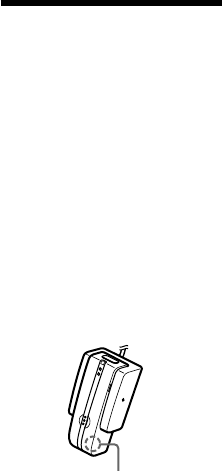
16
US
Precautions
On Bluetooth
communication
• Bluetooth wireless technology operates
within a range of about 10 m (about
30 ft). Maximum communication range
may vary depending on obstacles
(human body, metal, wall, etc.) or
electromagnetic environment.
•The aerial is built into the unit as
illustrated in the dotted line. The
sensitivity of Bluetooth communication
will improve by turning the direction of
the built-in aerial to the connected
Bluetooth device.
The communication distance shortens
when the obstacles are between the
aerial of the connected device and this
unit.
•The following conditions may affect the
sensitivity of Bluetooth communication.
–There is an obstacle such as human
body, metal, or wall between this unit
and Bluetooth device.
–A device using 2.4 GHz frequency,
such as a wireless LAN device,
cordless telephone, or microwave
oven, is in use near this unit.
•Because Bluetooth devices and wireless
LAN (IEEE802.11b/g) use the same
frequency, microwave interference may
occur and resulting in communication
speed deterioration, noise, or invalid
connection if this unit is used near a
wireless LAN device. In such a case,
perform the following.
–
Use this unit at least 10 m (about 30
ft)
away from the wireless LAN
device.
–If this unit is used within 10 m
(about 30 ft) of a wireless LAN
device, turn off the wireless LAN
device.
–Install this unit and Bluetooth
device as near to each other as
possible.
•Microwaves emitting from a
Bluetooth device may affect the
operation of electronic medical
devices. Turn off this unit and other
Bluetooth devices in the following
locations, as it may cause an accident.
–where inflammable gas is present,
in a hospital, train, airplane, or a
gas station
–near automatic doors or a fire alarm
•This unit supports security
capabilities that comply with the
Bluetooth standard to provide a
secure connection when the Bluetooth
wireless technology is used, but
security may not be enough
depending on the setting. Be careful
when communicating using Bluetooth
wireless technology.
•We do not take any responsibility for
the leakage of information during
Bluetooth communication.
•Connection with all Bluetooth
devices cannot be guaranteed.
–A device featuring Bluetooth
function is required to conform to
the Bluetooth standard specified by
Bluetooth SIG, Inc. and be
authenticated.
–Even if the connected device
conforms to the above mentioned
Bluetooth standard, some devices
may not be connected or work
correctly, depending on the features
or specifications of the device.
•Depending on the device to be
connected, it may require some time
to start communication.
Location of built-in aerial

17
US
Notes on using in a car
•Do not attempt to connect this unit, or
to operate this unit, an audio output
device or a car radio while driving or
waiting at a traffic signal.
•Make sure this unit and the device
connected to this unit are fixed firmly
before driving to avoid an accident or
damage.
•Route all the cable connected to this
unit properly so that they will not
interfere with your driving or become
entangled in parts of the car interior
(seat, door, etc.).
On the supplied AC power
adaptor
•Use the AC power adaptor supplied
with this unit. Do not use any other AC
power adaptor since it may cause the
unit to malfunction.
Polarity of the plug
• If you are not going to use this unit for
a long time, unplug the AC power
adaptor from the AC outlet. To remove
the AC power adaptor from the wall
outlet, grasp the adaptor plug itself;
never pull the cord.
Others
•Do not place the unit in any of the
following locations.
–Direct sunlight, near a heater, or other
extremely high-temperature location
– Dusty location
–Location exposed to large amounts of
vibration
–Bathroom or other high-humidity
location
–In a car subject to the direct rays of
the sun.
•Do not drop, hit, or otherwise expose
the unit to strong shock of any kind.
This could damage the product.
• If you experience discomfort after using
the Bluetooth device, stop using the
Bluetooth device immediately. Should
any problem persist, consult your
nearest Sony dealer.
•Do not allow small children to use this
unit.
•If you have any questions or problems
concerning this unit that are not covered
in this manual, please consult your
nearest Sony dealer.

18
US
Troubleshooting
If you run into any problems using this unit, use the following checklist and
read the product support information on our website. Should any problem
persist, consult your nearest Sony dealer.
Cannot make the Bluetooth
connection.
,Check that this unit is turned on.
,Check that the Bluetooth connecting
device is turned on and the Bluetooth
function is on.
,Connection with the Bluetooth device
may not be memorized on this unit.
Make the Bluetooth connection from
the Bluetooth device to this unit soon
after pairing is complete.
,This unit or Bluetooth connecting
device is in sleep mode.
,The Bluetooth connection is
terminated. Make the Bluetooth
connection again.
Cannot operate the unit.
(Connection has hung up.)
,Press the RESET button. Pairing
information is not deleted by this
operation.
Common
The unit is not turned on.
,Charge the battery of the unit.
,The unit is not turned on while
charging. Remove the unit from the
battery charging stand and then turn
on the unit.
Sound skips or the
correspondence distance
is short.
,
If a device that generates
electromagnetic radiation, such as a
wireless LAN, other Bluetooth
device(s), or a microwave oven is
nearby, move away from such sources.
,Remove any obstacle between this
unit and other Bluetooth device or
move away from the obstacle.
,Locate this unit and other Bluetooth
device(s) as near as possible.
,Re-position this unit.
Pairing cannot be done.
,Bring this unit and the Bluetooth
device closer together.

19
US
When listening to
music
No sound
,Check the connection between this
unit and the stereo audio source
device connected to this unit.
,Check that both this unit and the
Bluetooth stereo audio receiving
device are turned on.
,Ensure that this unit is not too far
from the Bluetooth stereo audio
receiving device, or this unit is not
receiving interference from a wireless
LAN, other 2.4 GHz wireless device,
or microwave oven.
,Check that Bluetooth connection is
made properly between this unit and
the Bluetooth stereo audio receiving
device.
,Turn up the volume of the Bluetooth
stereo audio receiving device. For
details on volume adjustment, refer to
the operating instructions supplied
with the Bluetooth stereo audio
receiving device.
,Turn up the volume of the stereo
audio source device as high as
possible to the extent that sound is
not distorted.
,Pair this unit and the Bluetooth stereo
audio receiving device again (page
10).
Low sound level
,Turn up the volume of the stereo
audio source device as high as
possible to the extent that sound is
not distorted.
,Turn up the volume of the Bluetooth
stereo audio receiving device. For
details on volume adjustment, refer to
the operating instructions supplied
with the Bluetooth stereo audio
receiving device.
,Connect the audio in plug to the
headphone jack instead of the LINE
OUT jack.
Distorted sound
,Turn down the volume of the stereo
audio source device to the point
where the sound is no longer
distorted. For details on volume
adjustment, refer to the operating
instructions supplied with the stereo
audio source device.
,Connect the audio in plug to the
headphone jack instead of the LINE
OUT jack.
Cannot be connected to a
device that has been
paired and connected
before.
,This unit tries to connect with either
of the last two devices recognized
before. If this unit cannot make the
Bluetooth connection with a paired
device, pair the device again, or try
making the Bluetooth connection
from the Bluetooth stereo audio
receiving device if possible.
,Pairing information may be deleted.
Pair the device again (page 10).

20
US
Initializing the
unit
You can reset this unit to its default
(such as volume setting) and delete
all pairing information.
1If this unit is turned on,
press and hold the
POWER button for
about 3 seconds to turn
off this unit.
2Press and hold the
POWER button and the
initialize button together
for about 7 seconds.
The indicator (blue) and
indicator (red) flash together
four times, and this unit is
reset to the default setting. All
pairing information is deleted.

21
US
Specifications
General
Communication system
Bluetooth Specification version 2.0
Output
Bluetooth Specification Power Class 2
Frequency band
2.4 GHz band (2.4000 GHz – 2.4835 GHz)
Maximum communication range
Line of sight approx. 10 m (30 ft)*1
Modulation method
FHSS
Compatible Bluetooth Profile*2
A2DP (Advanced Audio Distribution
Profile)
Supported codec*3
SBC
*4
Audio input
Gold-plated L-shaped stereo mini plug × 1
Input impedance
Approx. 32 Ω
Power source
DC 3.7 V: Built-in lithium-ion
rechargeable battery
Dimensions
Approx. 25 × 51 × 29 mm
(1 × 2 × 1 3/16 in) (w/h/d)
Mass
Approx. 21 g (0.8 oz) (including cord)
*1The actual range will vary depending
on factors such as obstacles between
devices, magnetic fields around a
microwave oven, static electricity,
reception sensitivity, antenna’s
performance, operating system,
software application, etc.
*2Bluetooth standard profiles indicate
the purpose of Bluetooth
communication between devices.
*3Codec: Audio signal compression and
conversion format
*4Subband Codec
Supplied accessories
AC power adaptor (1)
Battery charging stand (1)
Operating instructions (this book) (1)
Design and specifications are subject to
change without notice.

2
ES
TMR-BT10A_U2 [US,ES] 3-280-223-11(1)
ADVERTENCIA
Para reducir el riesgo de incendios
o electrocución, no exponga el
aparato a la lluvia ni a la humedad.
Para evitar descargas eléctricas, no
abra la unidad. En caso de avería,
solicite los servicios de personal
cualificado.
No sitúe el aparato en un espacio cerrado,
como una estantería o un armario
empotrado.
Para reducir el riesgo de incendios, no
cubra la ventilación del aparato con
periódicos, manteles, cortinas, etc. ni
coloque velas encendidas encima del
mismo.
Para reducir el riesgo de incendio o
sacudida eléctrica, no ponga objetos que
contengan líquido, tal como floreros,
encima del aparato.
Conecte el adaptador de alimentación de
ca a una toma de ca de fácil acceso. Si
percibe alguna anormalidad en el
adaptador de alimentación de ca,
desconéctelo inmediatamente de la toma
de ca.
No exponga la pila a fuentes de calor
excesivo como luz solar directa, fuego o
similar.
Información
Se le advierte de que la realización de
cambios o modificaciones no aprobados
explícitamente en este manual pueden
anular su autoridad para utilizar este
equipo.
El equipo no debe colocarse ni utilizarse
junto con ninguna otra antena o
transmisor.
La marca de la palabra Bluetooth y sus
logotipos son propiedad de Bluetooth
SIG, Inc. y cualquier uso de los mismos
por parte de Sony Corporation se realiza
bajo licencia.
Las demás marcas y nombres comerciales
pertenecen a sus respectivos propietarios.
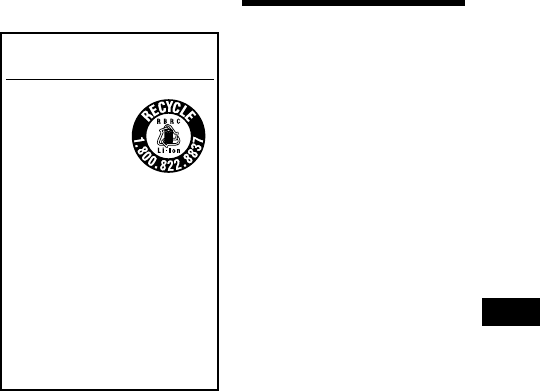
3
ES
TMR-BT10A_U2 [US,ES] 3-280-223-11(1)
ES
Índice
¿Qué es la tecnología
inalámbrica
Bluetooth? .................... 4
Bienvenido ........................ 5
Uso de la función Bluetooth con
sólo 3 pasos ............................ 6
Ubicación y función de los
componentes ................ 7
Carga de la unidad ........... 8
Emparejamiento ............. 10
¿Qué es el emparejamiento? ... 10
Procedimientos de
emparejamiento .................. 10
Indicaciones de la función
Bluetooth ..................... 12
Escuchar música ........... 13
Desecho de la unidad .... 15
Precauciones .................. 16
Solución de problemas ... 18
Inicialización de la
unidad .......................... 20
Especificaciones ............ 21
Para clientes de los EE UU
RECYCLADO DE BATERIAS
DE IONES DE LITIO
Las baterías de
iones de litio son
reciclables. Usted
podrá ayudar a
conservar el medio
ambiente
devolviendo las
baterías usadas al
punto de reciclaje
mas cercano.
Para más información sobre el
reciclado de baterías, llame al
número gratuito
1-800-822-8837, o visite
http://www.rbrc.org/
Precaución: No utilice baterías de
iones de litio dañadas o con fugas.

4
ES
TMR-BT10A_U2 [US,ES] 3-280-223-11(1)
¿Qué es la tecnología inalámbrica
Sistema de comunicación
y perfiles Bluetooth
compatibles de la unidad
Un perfil es una estandarización de
la función para cada especificación
del dispositivo Bluetooth. Esta
unidad es compatible con el perfil y
la versión Bluetooth siguientes:
Sistema de comunicación:
Especificación Bluetooth versión 2.0
Perfil Bluetooth compatible:
–A2DP (Advanced Audio Distribution
Profile)
Bluetooth?
BluetoothTM es una tecnología
inalámbrica de corto alcance que
permite la comunicación
inalámbrica de datos entre
dispositivos digitales como, por
ejemplo, una computadora o una
cámara digital. La tecnología
inalámbrica Bluetooth funciona en
un rango de aproximadamente 10
metros.
Lo habitual es conectar dos
dispositivos, pero algunos
dispositivos admiten la conexión a
varios dispositivos a la vez.*
No es necesario utilizar un cable
para realizar la conexión, ni
tampoco es necesario encarar los
dispositivos entre sí, como sucede
con la tecnología de infrarrojos. Por
ejemplo, puede utilizar los
dispositivos en una bolsa o en un
bolsillo.
El estándar Bluetooth es una
convención internacional reconocida
y utilizada por miles de empresas de
todo el mundo.
*Esta unidad no puede conectarse a
varios dispositivos a la vez.
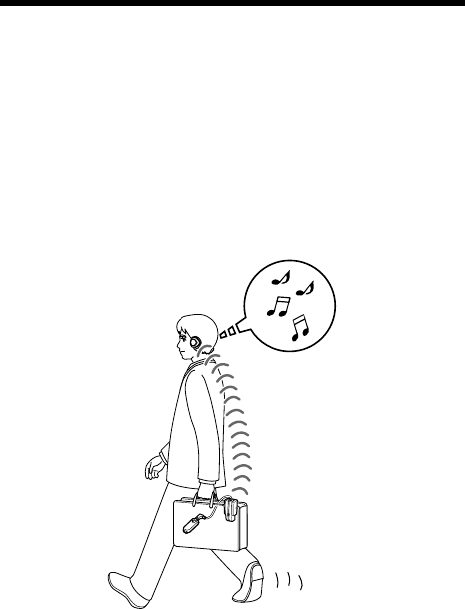
5
ES
TMR-BT10A_U2 [US,ES] 3-280-223-11(1)
Bienvenido
Gracias por adquirir el transmisor estéreo portátil de Sony. Esta unidad
utiliza la tecnología inalámbrica Bluetooth.
•Transmisor inalámbrico para el flujo de música estéreo de alta calidad del
reproductor de música digital.
•Transmite música a otros dispositivos con tecnología inalámbrica
Bluetooth.*
•Práctica función de recarga.
Disfrute escuchando música
*El dispositivo Bluetooth conectado debe ser compatible con el perfil A2DP
(Advanced Audio Distribution Profile).
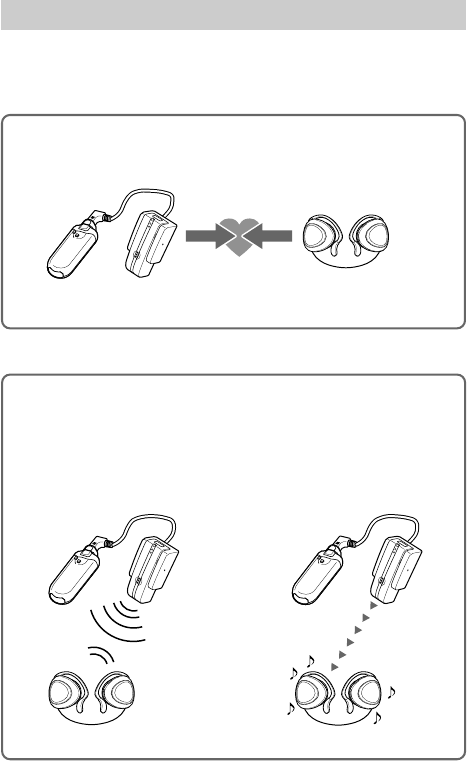
6
ES
TMR-BT10A_U2 [US,ES] 3-280-223-11(1)
Uso de la función Bluetooth con sólo 3 pasos
En el ejemplo siguiente se describe cómo transmitir música reproducida en el
dispositivo de audio conectado a la unidad y escuchar música en un dispositivo
Bluetooth receptor de audio estéreo (auriculares, sistema de audio estéreo, etc.).
Emparejamiento
Permite que un dispositivo Bluetooth receptor de audio estéreo y esta
unidad se puedan reconocer mutuamente.
Conexión Bluetooth
Al encender la unidad, se
activa automáticamente la
conexión Bluetooth entre la
unidad y el dispositivo
Bluetooth receptor de audio
estéreo.
Transmisión de música
Puede escuchar la música que
se reproduce en el reproductor
de audio portátil, etc. conectado
a esta unidad a través de un
sistema Bluetooth de recepción
de audio.
b
v
Transmisor
estéreo portátil
Conexión
Emparejamiento
Señal de
audio estéreo
(Flujo)
Dispositivo
de audio
Para obtener más información,
consulte las páginas 10 y 11.
Para obtener más información, consulte las páginas 13 y 14.
Dispositivo Bluetooth
receptor de audio estéreo
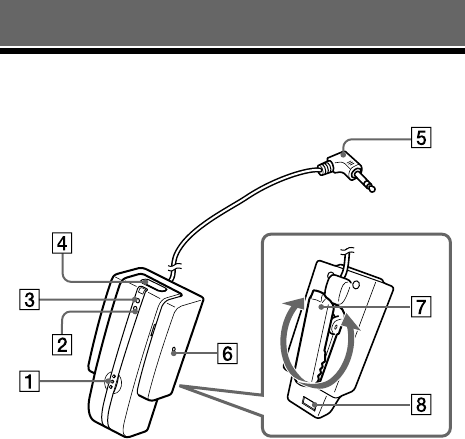
7
ES
TMR-BT10A_U2 [US,ES] 3-280-223-11(1)
Ubicación y función de los
componentes
1Botón de inicialización
2Indicador (rojo)
Indica el estado de la
alimentación de la unidad.
3Indicador (azul)
Indica el estado de la
comunicación de la unidad.
4Botón POWER
5Clavija de entrada de
audio (miniclavija
estéreo dorada en
forma de L)
Se conecta a la toma de
auriculares de un reproductor
de audio portátil, etc.
6Botón RESET
Púlselo cuando la unidad esté
inoperante.
Con esta operación no se
elimina la información de
emparejamiento.
7Clip de sujeción
Ajuste el clip de sujeción en el
ángulo deseado y fíjelo en el
bolso o maletín.
8Punto de contacto para
el soporte de carga de
la batería
PROCEDIMIENTOS INICIALES
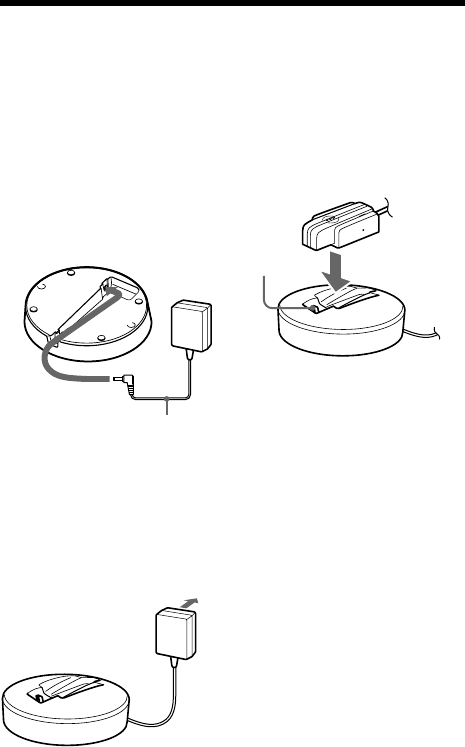
8
ES
TMR-BT10A_U2 [US,ES] 3-280-223-11(1)
1Conecte el adaptador de
alimentación de ca
suministrado con el
soporte de carga de la
batería.
2Conecte el adaptador de
alimentación de ca
suministrado a un
tomacorriente de ca.
Carga de la unidad
La unidad contiene una batería de iones de litio recargable, que se debe
cargar antes de utilizarla por primera vez.
Soporte de carga
de la batería
(suministrado)
(Parte
posterior)
Adaptador de
alimentación de
ca (suministrado)
3Coloque la unidad en el
soporte de carga de la
batería.
Nota
Si el clip de sujeción está girado, la
unidad no se puede colocar en el
soporte de carga de la batería y la
carga no se iniciará. Coloque de
nuevo el clip de sujeción en su
posición original antes de iniciar la
carga.
Coloque la unidad sobre el
soporte de carga de la batería de
modo que el punto de contacto
de la unidad coincida con el pin
de contacto de dicho soporte, y
asegúrese de que el indicador
(rojo) se ilumine.
La carga se completa en
aproximadamente 3 horas* y el
indicador (rojo) se apaga
automáticamente.
* Tiempo necesario para volver a cargar
una batería agotada.
a un
tomacorriente
de ca
Soporte de carga
de la batería
(suministrado)
Transmisor estéreo
portátil
Pin de
contacto

9
ES
TMR-BT10A_U2 [US,ES] 3-280-223-11(1)
Duración
aproximada
11 horas
Estado
Completa
Media
Baja
(debe
cargarla)
Sugerencia
Al cargar la batería, la unidad se apaga
automáticamente.
Precaución
Si la unidad detecta un problema
durante la carga, es posible que el
indicador (rojo) se apague aunque
no haya finalizado la carga.
Compruebe si se debe a las causas
siguientes:
–La temperatura ambiente excede la
gama entre los 0 °C y los 40 °C.
–La batería tiene un problema.
En este caso, cárguela de nuevo
entre las temperaturas indicadas
anteriormente.
Si el problema persiste, póngase en
contacto con el distribuidor Sony
más cercano.
Notas
•Si no se utiliza la batería durante un
período de tiempo prolongado, es
posible que la carga se agote
rápidamente. Sin embargo, después de
varias recargas, aumentará la duración.
•Si la vida útil de la batería recargable
incorporada disminuye hasta la mitad
de la duración normal, la batería deberá
reemplazarse. Para reemplazar la
batería recargable, póngase en contacto
con el distribuidor Sony más cercano.
•Evite la exposición de la unidad a
temperaturas extremas, la luz solar
directa, la humedad, la arena, el polvo o
los golpes. No la deje nunca en un
automóvil estacionado al sol.
•Utilice únicamente el adaptador de
alimentación de ca suministrado. No
utilice ningún otro adaptador de
alimentación de ca.
Duración*
Estado
Tiempo de
reproducción de
música (máximo)
*Estos tiempos pueden variar según la
temperatura ambiente o las condiciones
de uso.
Comprobación de la
batería restante
Si presiona el botón POWER
mientras la unidad está encendida, el
indicador (rojo) parpadeará. Puede
comprobar la batería restante
mediante el número de veces que
parpadea el indicador (rojo).
Indicador (rojo)
3 veces
2 veces
1 vez
Nota
No es posible comprobar la batería
restante inmediatamente después de
encender la unidad ni durante el proceso
de emparejamiento.
Cuando la batería está
prácticamente agotada
El indicador (rojo) parpadea lentamente
de forma automática.
Cuando la batería se agota por completo,
la unidad se apaga automáticamente.
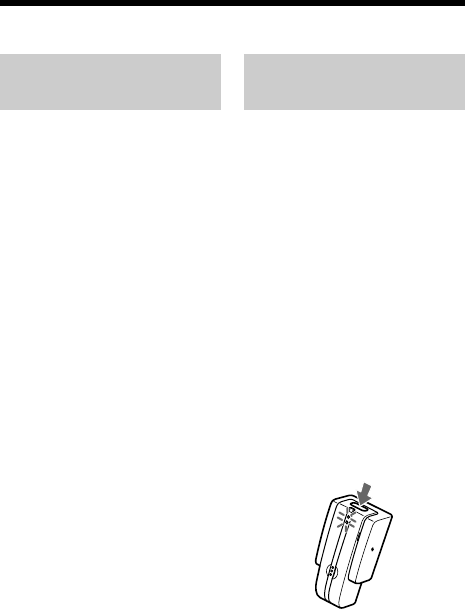
10
ES
TMR-BT10A_U2 [US,ES] 3-280-223-11(1)
Emparejamiento
¿Qué es el
emparejamiento?
Los dispositivos Bluetooth deben
“emparejarse” previamente entre sí.
Una vez que los dispositivos
Bluetooth se emparejaron, no es
necesario volver a hacerlo excepto
en los casos siguientes:
•Cuando la información de
emparejamiento se eliminó tras
una reparación, etc.
•Cuando la unidad se emparejó
con 9 o más dispositivos.
Esta unidad se puede emparejar
con hasta 8 dispositivos
Bluetooth; si se empareja un
noveno dispositivo, éste
reemplazará al dispositivo con la
fecha de conexión más antigua de
los 8 restantes.
•Cuando se elimina el
reconocimiento de la unidad en el
dispositivo que desea conectar.
•Cuando se inicializó esta unidad
(página 20). Se elimina toda la
información de emparejamiento.
Nota
El código de acceso* de la unidad es
“0000”. Esta unidad no podrá emparejarse
con otro dispositivo Bluetooth receptor
cuyo código de acceso no sea “0000”.
*Es posible que se denomine al código
de acceso “clave de acceso”, “código
PIN”, “número PIN” o “contraseña”.
Procedimientos de
emparejamiento
1Coloque el dispositivo
Bluetooth receptor a 1
metro como máximo de
la unidad.
2Mantenga presionado el
botón POWER durante 7
segundos como mínimo
para que el
emparejamiento entre
en modo de espera
mientras se apaga la
unidad.
Los indicadores (azul) y (rojo)
empiezan a parpadear a la vez y
la unidad inicia la búsqueda de
dispositivos Bluetooth
receptores.
11
ES
TMR-BT10A_U2 [US,ES] 3-280-223-11(1)
Notas
•Transcurridos 3 segundos
aproximadamente, la alimentación
se enciende, y los indicadores
(azul) y (rojo) parpadean juntos
dos veces. Mantenga presionado
el botón hasta que ambos
indicadores comiencen a
parpadear a la vez y, a
continuación, suéltelo.
La unidad pasa al modo de
emparejamiento.
•Si el emparejamiento no se
estableció en unos 5 minutos, el
modo de emparejamiento se
cancelará y la unidad se apagará.
En tal caso, vuelva a comenzar
desde el paso 1.
3Ajuste el dispositivo
Bluetooth receptor en
el modo de
emparejamiento.
La unidad buscará
automáticamente otro
dispositivo Bluetooth receptor
y lo emparejará.
La unidad intentará conectar el
dispositivo Bluetooth receptor
tan pronto como lo detecte.
Cuando la conexión Bluetooth
se haya realizado
correctamente, el indicador
(rojo) se apagará y el indicador
(azul) empezará a parpadear
lentamente, lo que indica que el
emparejamiento finalizó y que
la información de
emparejamiento se memorizó
en la unidad.
Notas
•Si se solicita un código de acceso
en el dispositivo Bluetooth
receptor, introduzca “0000”.
•En la pantalla de algunos
dispositivos Bluetooth receptores
aparecerá un mensaje que indica
que finalizó el emparejamiento.
•Es posible que algunos dispositivos
Bluetooth se conecten directamente
con esta unidad al finalizar el
emparejamiento.
Sugerencias
•Para realizar un emparejamiento con
otro dispositivo Bluetooth, repita los
pasos del 1 al 3 para cada uno de ellos.
•Para eliminar toda la información de
emparejamiento, consulte
“Inicialización de la unidad”
(página 20).
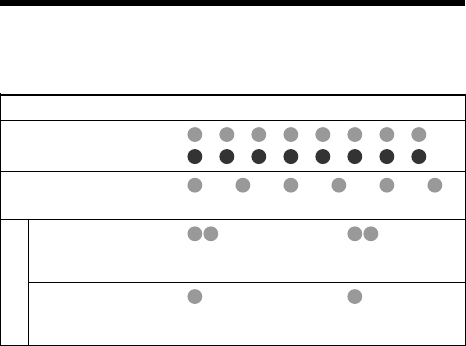
12
ES
TMR-BT10A_U2 [US,ES] 3-280-223-11(1)
Indicaciones de la función Bluetooth
B : Indicador (azul)
R : Indicador (rojo)
Estado Patrones de parpadeo
Emparejamiento B – – – – – – – – ...
R – – – – – – – – ...
Conexión B – – – – – – – – – – ...
R
–
Escucha B – – – – – – – – – – – – ...
R
–
Sin reproducción B – – – – – – – – – – – – – – ...
de música R
–
Conexión establecida
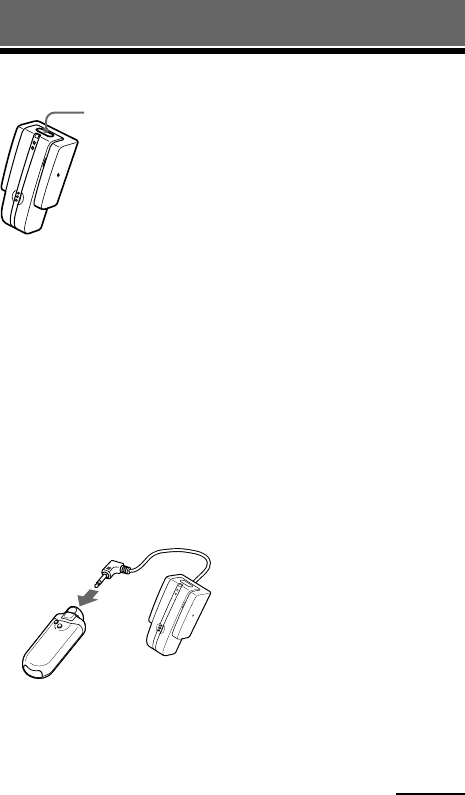
13
ES
TMR-BT10A_U2 [US,ES] 3-280-223-11(1)
Escuchar música
2Encienda el dispositivo
fuente de audio estéreo.
3Con la unidad apagada,
mantenga presionado el
botón POWER durante
aproximadamente
3 segundos.
Los indicadores (azul) y (rojo)
parpadean al unísono dos veces
y, a continuación, la unidad se
enciende.
Tras encenderse, la unidad se
conecta automáticamente con el
dispositivo Bluetooth receptor.
Notas
•No mantenga presionado el botón
POWER durante más de 7
segundos. De lo contrario, la
unidad entrará en el modo de
emparejamiento.
•Asegúrese de encender sólo el
dispositivo Bluetooth receptor que
desee conectar con esta unidad. Si
hay más de un dispositivo
Bluetooth receptor encendido, es
posible que la conexión no se
realice como desea.
•Si esta unidad no puede llevar a
cabo la conexión Bluetooth con un
dispositivo emparejado, vuelva a
emparejarlos, o bien intente realizar
la conexión Bluetooth desde el
dispositivo Bluetooth receptor si es
posible.
USO DE LA UNIDAD
Antes de utilizar la unidad,
compruebe los puntos siguientes.
–El emparejamiento de esta unidad
y el dispositivo Bluetooth
receptor finalizó.
–El dispositivo Bluetooth receptor
se encuentra en espera para
realizar la conexión.
–El dispositivo Bluetooth receptor
admite la función de recepción de
música (perfil: A2DP*).
1Conecte la miniclavija
estéreo de la unidad a la
toma de auriculares de
un dispositivo fuente de
audio estéreo.
Nota
Cuando realice la conexión a un
dispositivo fuente de audio estéreo,
asegúrese de que conecta la unidad a
la toma de auriculares y no a la toma
LINE OUT.
Botón POWER
Continúa
14
ES
TMR-BT10A_U2 [US,ES] 3-280-223-11(1)
Notas
•Aunque el dispositivo Bluetooth
receptor admita el perfil AVRCP
(Audio Video Remote Control Profile),
la unidad no podrá realizar funciones de
control de la reproducción.
•En los casos siguientes, deberá volver a
realizar la conexión Bluetooth.
–La alimentación de esta unidad no se
enciende.
–La alimentación del dispositivo
Bluetooth receptor de audio estéreo
no se enciende o la función Bluetooth
está desactivada.
–La función Bluetooth de esta unidad
o el dispositivo Bluetooth receptor de
audio estéreo se encuentra en modo
de desconexión temporal.
–No se realizó la conexión Bluetooth.
Para detener el uso
1Apague el dispositivo
Bluetooth receptor.
2Mantenga presionado el
botón POWER de la
unidad durante unos 3
segundos.
Los indicadores (azul) y (rojo)
se iluminan a la vez y la unidad
se apaga.
Sugerencia
Cuando finalice la reproducción de
música, es posible que la conexión
Bluetooth finalice automáticamente,
según el dispositivo Bluetooth que se
utilice.
Sugerencias
•El indicador (azul) sigue
parpadeando mientras la unidad
busca un dispositivo Bluetooth
receptor.
•Si se emparejan dos o más
dispositivos con la unidad, ésta
intentará conectar con uno de los
dos últimos dispositivos que
reconoció anteriormente.
•Se estableció la conexión Bluetooth
de la unidad con el perfil A2DP
(Advanced Audio Distribution
Profile)*.
•Para obtener más información
sobre el funcionamiento del
dispositivo Bluetooth receptor,
consulte las instrucciones de
funcionamiento suministradas con
el dispositivo.
*
Para obtener más información sobre
los perfiles, consulte la página 4.
4Inicie la reproducción
en el dispositivo fuente
de audio estéreo
conectado a la unidad.
Notas
•Si el sonido aparece distorsionado,
baje el volumen del dispositivo
conectado.
•Si el volumen es bajo o aparece
ruido, suba el volumen del
dispositivo conectado.
•Desactive las funciones de
potenciación de graves y
ecualizador. Si están activadas, el
sonido podría distorsionarse.
Sugerencias
•Suba el volumen del dispositivo
fuente de audio estéreo al máximo
posible siempre que no se
distorsione el sonido y, a
continuación, ajuste el volumen del
dispositivo Bluetooth receptor en
un nivel moderado.
•Si la unidad se encuentra en un
bolso, es posible que la conexión
Bluetooth pierda calidad. Fije la
unidad en el bolso.
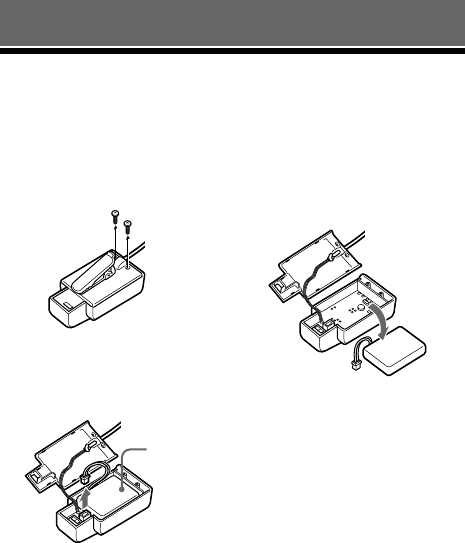
15
ES
TMR-BT10A_U2 [US,ES] 3-280-223-11(1)
Desecho de la unidad
Para una mejor conservación del medio ambiente, asegúrese de retirar la
batería recargable incorporada antes de deshacerse de la unidad y proceda al
desecho de dicha batería de la forma adecuada.
INFORMACIÓN COMPLEMENTARIA
1Retire los 2 tornillos.
2Abra la carcasa y
extraiga el conector.
3Extraiga la batería
recargable y deséchela.
Batería
recargable
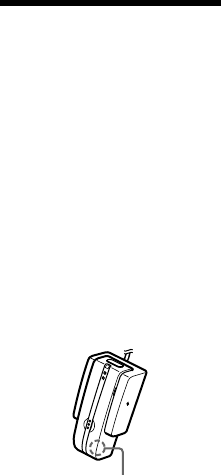
16
ES
TMR-BT10A_U2 [US,ES] 3-280-223-11(1)
Precauciones
Comunicación Bluetooth
•La tecnología inalámbrica Bluetooth
funciona en un rango de
aproximadamente 10 metros.
El rango máximo de comunicación
puede variar en función de los
obstáculos (persona, objetos metálicos,
paredes, etc.) o del entorno
electromagnético.
•La antena está incorporada en la unidad
como se muestra con la línea de puntos.
La sensibilidad de la comunicación
Bluetooth mejorará al girar la antena
incorporada en la unidad hacia el
dispositivo Bluetooth conectado.
La distancia de comunicacion se reduce
cuando existen obstaculos entre la
antena del dispositivo conectado y esta
unidad.
•Las condiciones siguientes pueden
afectar la sensibilidad de la
comunicación Bluetooth.
–La existencia de obstáculos como,
por ejemplo, persona, un objeto
metálico o una pared entre esta
unidad y el dispositivo Bluetooth.
–El uso de dispositivos que utilicen
una frecuencia de 2,4 GHz como, por
ejemplo, un dispositivo LAN
inalámbrico, un teléfono inalámbrico
o un microondas cerca de la unidad.
•Como los dispositivos Bluetooth y las
LAN inalámbricas (IEEE802.11b/g)
utilizan la misma frecuencia, pueden
producirse interferencias de
microondas que provoquen el
deterioro de la velocidad de la
comunicación, la aparición de ruido o
una conexión no válida si la unidad se
utiliza cerca de un dispositivo LAN
inalámbrico. En este caso, realice el
procedimiento siguiente.
–Utilice esta unidad a una distancia
mínima de 10 m del dispositivo
LAN inalámbrico.
– Si utiliza esta unidad a menos de
10 m de un dispositivo LAN
inalámbrico, apague el dispositivo
LAN inalámbrico.
–Instale esta unidad y el dispositivo
Bluetooth a la distancia más corta
posible entre sí.
•
Las microondas que emite un
dispositivo Bluetooth pueden afectar
el funcionamiento de dispositivos
médicos electrónicos. Apague esta
unidad y los demás dispositivos
Bluetooth en los lugares siguientes, ya
que podrían provocar un accidente:
–donde exista gas inflamable, en un
hospital, tren, avión o gasolinera
–cerca de puertas automáticas o
alarmas de incendios
• Esta unidad admite capacidades de
seguridad que cumplen con el
estándar Bluetooth para proporcionar
una conexión segura al utilizar la
tecnología inalámbrica Bluetooth,
pero es posible que la seguridad no
sea suficiente según el ajuste. Tenga
cuidado al realizar una comunicación
con la tecnología inalámbrica
Bluetooth.
•No se aceptan responsabilidades por
la pérdida de información que pudiera
producirse durante una comunicación
Bluetooth.
•No se puede garantizar la conexión
con todos los dispositivos Bluetooth.
–Un dispositivo que disponga de la
función Bluetooth debe cumplir el
estándar Bluetooth especificado por
Bluetooth SIG, Inc. y estar
autenticado.
Ubicación de la
antena incorporada

17
ES
TMR-BT10A_U2 [US,ES] 3-280-223-11(1)
–Incluso en el caso de que el
dispositivo conectado cumpla el
estándar Bluetooth mencionado
anteriormente, es posible que algunos
dispositivos no puedan conectarse o
funcionar correctamente, según las
características o las especificaciones
del dispositivo.
•En función del dispositivo que vaya a
conectarse, es posible que transcurra
cierto tiempo antes de que se inicie la
comunicación.
Notas sobre el uso en un
automóvil
•No intente conectar ni utilizar la unidad,
un dispositivo de audio portátil o una
radio de automóvil mientras maneja o
espera ante una señal de tráfico.
•Antes de empezar a manejar, asegúrese
de fijar de forma segura la unidad y el
dispositivo conectado a ésta para evitar
accidentes o daños.
•Dirija todo el cable conectado a la
unidad debidamente de forma que no
interfiera en el manejo ni quede
atrapado con otras partes del interior del
automóvil (asiento, puerta, etc.).
Adaptador de alimentación de ca
suministrado
•Utilice solamente el adaptador de
alimentación de ca suministrado con
esta unidad. No utilice ningún otro
adaptador de alimentación de ca, ya que
puede causar un mal funcionamiento de
la unidad.
Polaridad de la clavija
•Si no va a utilizar la unidad durante un
período prolongado de tiempo,
desconecte el adaptador de
alimentación de ca del tomacorriente de
ca. Para retirar el adaptador de
alimentación de ca del tomacorriente de
pared, tire del adaptador, nunca del
cable.
Otros
•No coloque la unidad en ninguno de los
lugares siguientes.
–Cerca de un calefactor, o en un lugar
expuesto a la luz solar directa o a
temperaturas extremadamente
elevadas
–En un lugar polvoriento
–En un lugar expuesto a fuertes
vibraciones
–En un cuarto de baño o en un lugar en
el que se condense mucha humedad
–Dentro de un automóvil expuesto a la
luz solar directa.
•No deje caer, golpee ni exponga la
unidad a impactos fuertes de ningún
tipo ya que, de lo contrario, podrían
producirse daños en el producto.
•Si no se siente cómodo después de
utilizar el dispositivo Bluetooth, deje de
utilizarlo inmediatamente. Si el
problema persiste, consulte con el
distribuidor Sony más cercano.
• No permita que los niños utilicen esta
unidad.
• Si desea realizar alguna consulta o
solucionar algún problema relativo a la
unidad que no se trate en este manual,
póngase en contacto con el distribuidor
Sony más cercano a su domicilio.

18
ES
TMR-BT10A_U2 [US,ES] 3-280-223-11(1)
Solución de problemas
Si tiene dificultades para utilizar esta unidad, sírvase de la siguiente lista de
comprobaciones y consulte la información de ayuda del producto en nuestro
sitio Web. Si el problema persiste, consulte con el distribuidor Sony más
cercano.
Común
La unidad no
se enciende
,Cargue la batería de la unidad.
,La unidad no se enciende mientras se
carga. Retire la unidad del soporte de
carga de la batería y enciéndala.
Se producen saltos en el
sonido o la distancia de
correspondencia es corta
,Si hay cerca un dispositivo que
genera radiación electromagnética
como, por ejemplo, una red LAN
inalámbrica, otro dispositivo
Bluetooth o un microondas, aleje la
unidad de estas fuentes.
,Retire cualquier obstáculo entre la
unidad y el otro dispositivo Bluetooth
o aléjese del obstáculo.
,Coloque esta unidad y el otro
dispositivo Bluetooth lo más cerca
posible.
,Cambie de posición la unidad.
No se puede llevar a cabo
el emparejamiento
,Acerque esta unidad y el dispositivo
Bluetooth.
No se realizó la conexión
Bluetooth
,Compruebe que la unidad está
encendida.
,Compruebe que el dispositivo
Bluetooth que desea conectar está
encendido y que la función Bluetooth
está activada.
,Es posible que la unidad no
memorice la conexión con el
dispositivo Bluetooth. Realice la
conexión Bluetooth del dispositivo
Bluetooth a la unidad inmediatamente
después de finalizar el
emparejamiento.
,Esta unidad o el dispositivo Bluetooth
que desea conectar está en modo en
espera.
,Finalizó la conexión Bluetooth.
Realice la conexión Bluetooth de
nuevo.
La unidad no funciona (se
colgó la conexión)
,Presione el botón RESET. Al realizar
esta operación, la información del
emparejamiento no se elimina.
Al escuchar música
No hay sonido
,Compruebe la conexión entre esta
unidad y el dispositivo fuente de
audio estéreo conectado a la unidad.
,Compruebe que tanto la unidad como
el dispositivo Bluetooth receptor de
audio estéreo están encendidos.
,Asegúrese de que la unidad no se
encuentra demasiado alejada del
dispositivo Bluetooth receptor de
audio estéreo, o de que no recibe
interferencias de una red LAN
inalámbrica, de otro dispositivo
inalámbrico de 2,4 GHz o de un
microondas.
19
ES
TMR-BT10A_U2 [US,ES] 3-280-223-11(1)
,Compruebe que la conexión
Bluetooth entre la unidad y el
dispositivo Bluetooth receptor de
audio estéreo se realizó
correctamente.
,Suba el volumen del dispositivo
Bluetooth receptor de audio estéreo.
Si desea obtener información
detallada sobre el ajuste del volumen,
consulte el manual de instrucciones
suministrado con el dispositivo
Bluetooth receptor de audio estéreo.
,Suba el volumen del dispositivo
fuente de audio estéreo al máximo
posible sin que se produzca una
distorsión del sonido.
,Empareje la unidad y el dispositivo
Bluetooth receptor de audio estéreo
de nuevo (página 10).
El nivel del sonido es bajo
,Suba el volumen del dispositivo
fuente de audio estéreo al máximo
posible sin que se produzca una
distorsión del sonido.
,Suba el volumen del dispositivo
Bluetooth receptor de audio estéreo.
Si desea obtener información
detallada sobre el ajuste del volumen,
consulte el manual de instrucciones
suministrado con el dispositivo
Bluetooth receptor de audio estéreo.
,Conecte la clavija de entrada de audio
a la toma de auriculares en vez de a la
toma LINE OUT.
El sonido aparece
distorsionado
,Baje el volumen del dispositivo
fuente de audio estéreo hasta que el
sonido deje de aparecer
distorsionado. Si desea obtener
información detallada sobre el ajuste
del volumen, consulte el manual de
instrucciones suministrado con el
dispositivo fuente de audio estéreo.
,Conecte la clavija de entrada de audio
a la toma de auriculares en vez de a la
toma LINE OUT.
No es posible establecer
una conexión con un
dispositivo que se
emparejó y conectó
anteriormente
,La unidad intenta establecer una
conexión con alguno de los dos
últimos dispositivos que reconoció
anteriormente. Si la unidad no puede
realizar la conexión Bluetooth con un
dispositivo emparejado, empareje el
dispositivo de nuevo o, si es posible,
intente establecer la conexión
Bluetooth desde el dispositivo
Bluetooth receptor de audio estéreo.
,Es posible que la información de
emparejamiento se elimine.
Empareje el dispositivo de nuevo
(página 10).

20
ES
TMR-BT10A_U2 [US,ES] 3-280-223-11(1)
Inicialización de
la unidad
Puede restablecer la unidad a la
configuración predeterminada (así
como el volumen) y eliminar la
información de emparejamiento.
1Si la unidad está
encendida, mantenga
presionado el botón
POWER durante unos
3 segundos para
apagarla.
2Mantenga pulsado el
botón POWER y el de
inicialización a la vez
durante unos 7
segundos.
Los indicadores (azul) y (rojo)
parpadearán juntos cuatro veces
y la unidad se restablecerá a los
ajustes predeterminados. Toda la
información de emparejamiento
se elimina.
TMR-BT10A_U2 [US,ES] 3-280-223-11(1)
TMR-BT10A_U2 [US,ES] 3-280-223-11(1)

21
ES
TMR-BT10A_U2 [US,ES] 3-280-223-11(1)
Especificaciones
Generales
Sistema de comunicación
Especificación Bluetooth versión 2.0
Salida
Clase de potencia 2 de especificación
Bluetooth
Banda de frecuencia
Banda de 2,4 GHz (2,4000 GHz –
2,4835 GHz)
Rango de comunicación máximo
Línea de vista de aprox. 10 m *1
Método de modulación
FHSS
Perfil Bluetooth compatible
*
2
A2DP (Advanced Audio Distribution
Profile)
Códec admitido
*
3
SBC*4
Entrada de audio
1 miniclavija estéreo dorada en forma de
L
Impedancia de entrada
Aprox. 32 Ω
Fuente de alimentación
cc de 3,7 V: Batería recargable de iones
de litio incorporada
Dimensiones
Aprox. 25 × 51 × 29 mm (an/al/prf)
Peso
Aprox. 21 g (incluyendo el cable)
*1El rango real variará en función de
factores como, por ejemplo, los
obstáculos que puedan interponerse
entre los dispositivos, los campos
magnéticos que puedan existir en torno
a hornos microondas, la electricidad
estática, interferencias, las condiciones
de las ondas radioeléctricas, la
sensibilidad de recepción o el
rendimiento de la antena, del sistema
operativo, de la aplicación de software,
etc.
*2Los perfiles estándar Bluetooth
indican la finalidad de la
comunicación Bluetooth entre
dispositivos.
*3Códec: Formato de compresión y
conversión de señal de sonido
*4Códec Sub band
Accesorios suministrados
Adaptador de alimentación de ca (1)
Soporte del cargador de la batería (1)
Manual de instrucciones
(este documento) (1)
El diseño y las especificaciones están
sujetos a cambios sin previo aviso.

Printed in Malaysia
(1)